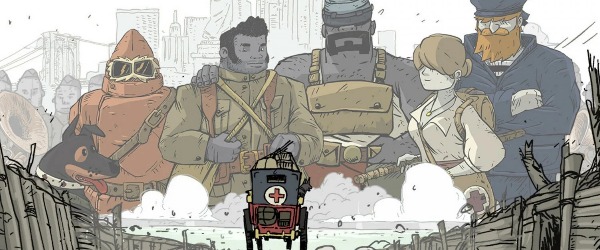
Halo Infinite (XS) - Review
by Lee Mehr , posted on 08 January 2022 / 5,919 ViewsReviewer's Note: This review accommodates the updates 343 Industries has made to the game's multiplayer since launch. It also includes SPOILERS for both Halo 4 & Halo 5: Guardians, in order to properly convey some praises & complaints regarding Infinite's story.
Six years is a damn long time for a Halo fan. Sure, 343 Industries has had no shortage of collaborative work since the fan-maligned Halo 5: Guardians, from novels to Halo Wars 2, but waiting that long for the next mainline FPS entry felt like an eternity. When considering the mounting hype, its one-year delay announcement, the creative leads exiting stage left during development, and the pandemic issues that've affected every developer, that weight to deliver got heavier by the day. Although those factors have resulted in a content-trimmed launch, this is the first time 343 has lived up close to this series' past pedigree.
The year is 2559. After Atriox and The Banished - a growing splinter faction of previous Covenant alien forces - board the UNSC Infinity, Master Chief is holding out in one of the ship's bays before he's brutally defeated. The last thing he sees is Atriox gloating and tossing him into the vacuum of space. Fast-forward six months later, a lonely pilot is drifting through the space battle's wreckage when he happens upon Chief. After jumpstarting his suit, Chief is compelled to get some payback against The Banished and disrupt their plans for the currently-inactive Zeta Halo ring.
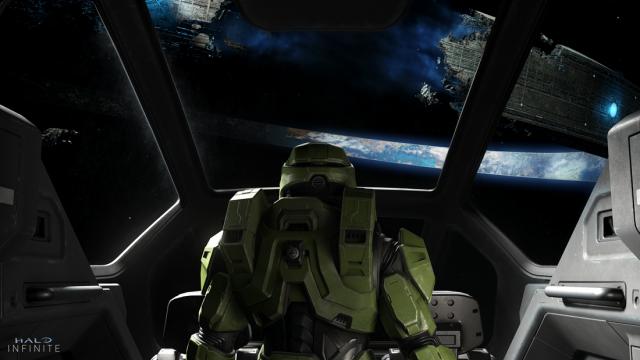
For anyone not greatly invested in Halo's story, your eyes may have glazed over that synopsis. There's one crucial takeaway for both Infinite's story and my assessment of it here: Halo has been a victim of its own doing since Bungie's tenure concluded. When 343 initially pitched "The Reclaimer Trilogy," the surprisingly dense lore that was previously background noise played a more prominent role. Now added atop the basic naming conventions in earlier Halos (Covenant, Prophets, UNSC, and The Flood), Halo 4 & 5's new slew of writers thought overly-expositive scenes about Forerunners, The Didact, Prometheans, and so on was the way to go. Twice the explaining to know half as much. Guardians' storyline likely had more work done on its marketing of Chief now being a rogue agent than its unfocused, nutty plot.
What this wall of waffle is trying to convey is Infinite isn't just a natural continuation; it's practically a salvage job. Just like Guardians before it, specific plotlines are quickly brushed aside. Chief's six-month nap means major developments have finished off-screen and you're picking up the pieces. To its credit, the gradual way those arcs conclude is well-handled. By placing more focus on Chief's limited crew – himself, Cortana-esque AI called "The Weapon," pilot Echo-216 – and lead baddie Escharum, it's easier to enjoy the trope-y sci-fi blockbuster. The salvage was mostly successful.
343 has to do more than properly grapple with past sins to produce a great story, right? Taken on its own, there's a decent space opera here. Weapon may be too quippy at times, but her levity is a good balance to Chief's austere tone. Escharum comfortably assumes the role of an irascible cartoon villain, but I enjoyed actor Darin De Paul hamming him up in every scene. It's a generic but effective reminder of your ultimate target. The argumentative, scared pilot won't win over many fans, but he does have valid reasoning for acting that way and provides another interesting contrast to the hoo-rah! marines found everywhere else.

This perspective doesn't necessarily translate to me being fully sold on them either. A few of the emotionally-heavy moments didn't quite sell me to the extent the game thought it had. A bit more time could've gone a long way to fully selling me. Time management is a fair critique in other respects, especially for a newer foe in the series. Because of their limited screen time beforehand, the climax loses its luster. Considering how often the main campaign repeats Escharum's threats, a more effective use of time could've been spent on the other enemy faction.
Presentation falls between a mix of good and odd elements. Voice acting all around is quite respectable. The standout performance to me is Jen Taylor's role trio: The Weapon, Cortana, and Dr. Halsey (creator of those AI programs). Considering how limited Steve Downes' lines are by comparison, she does the heavy lifting as the ostensible co-lead here. A collection of composers – in this case Gareth Coker, Joel Corelitz, and Curtis Schweitzer – would typically concern me that there were too many cooks in the kitchen; however, the end result ranks as both 343's best OST yet and its most effectively-utilized one during emotional beats. There aren't weird misfires nor thematic clashes between visual and aural storytelling.
On the visual end, it's often a visual treat but sometimes distracting. Despite the game running at a consistent 60fps, all facial animations are locked at 30fps for some reason. Also, I don't get this fad of making the campaign feel like a single tracking shot. God of War (2018) did this better, but I still think it's more of a vapid developer statement than a useful innovation. Tracking shots in movies are more admirable because of the incredible amount of moving parts needed to actually pull it off; by contrast, someone could construct a tracking shot of a game cut scene from an infinite number of different takes. There isn't that risk of one screw-up either ruining that take or having to push through it (see: Children of Men).
For a scale as vast as the game's title implies, Infinite's story strengths lie in its more insular dilemmas. It's still obligated to rummage through its predecessors' audacious nonsense, which’ll likely poison your overall outlook, but those issues are handled relatively well. When the scope becomes grander and promised future conflicts more ambiguous is when it starts hopping the tracks. This and other supplementary issues are modest detriments; despite that, the main dynamics at play still kept me thoroughly hooked.

Where Infinite shines brightest is its gameplay. Upon launching on Xbox, Halo: Combat Evolved made itself known by being the must-have FPS, and this is the closest it's been to attaining that crown in a while.
If you're familiar with Halo's sandbox, you mostly know what to expect: a sci-fi super soldier with sci-fi gimmicks shown on your HUD, a panoply of diverse weaponry (alien and human), two-weapon limit, third-person view when hauling a turret, dual health/shield dichotomy, vehicular combat, a variety of aliens to pummel, and so on. The biggest core changes from previous Halos is swapping between 4 grenades types and 4 Spartan abilities – one of said abilities being a grappling hook. That grappling hook alone exponentially expands your action vocabulary; not only as means of flying out of danger but of hooking weapons, handheld explosive barrels, enemies, vehicles, and Jackal shields for a quick stun. One simple addition adds more to rethinking Halo's gameplay loop than 5's integrated Spartan powers.
Even though the grappling hook is the most prominent addition, virtually every encounter is a joy because everything comes together. The sumptuous, booming chaos you can inflict in seconds has never been done to this scale for Halo outside of scripted events. But it rarely, if ever, loses itself in constantly throwing ridiculous odds at you. At times, I thought 343 had discovered a scientific formula to encounter design because so many white-knuckle, protracted fights on Heroic difficulty hit the perfect balance of toughness and fairness. Combined with the impactful & varied sound design, Infinite's gameplay is an absolute joy.

When I previously mentioned the biggest core changes to Halo found here, I left out the most important one: an open world. Yes, Halo has finally been tempted to adopt Far Cry's template. After the first two linear missions, Zeta Halo is – mostly – free to be enjoyed at your own pace. Certain portions are locked until the main story progresses, but the world eventually expands, as do your responsibilities: UNSC distress calls, forward operating bases (FOBs) to seize, special mini-dungeons, humorous propaganda towers, high-priority targets that'll net special weapon variants, and various story or upgrade collectibles. The world is now your oyster, but here's a grocery list to keep your attention.
I'll admit: ever since stepping onto the ring in Combat Evolved I've wanted it to take this route at least once. Although 343 didn't capture its full potential, I'm still pleased with the... more-manageable Ubisoft approach. Having checklists isn't inherently bad design. It's about approach and the work done to incorporate them into the locale. Given how humanity's in dire straits here, it makes sense to have small pockets of resistance or empty sleeping bags with a nearby audio log. Humanity's assumed to have lost and any victories are mere table scraps compared to The Banished's main mission.
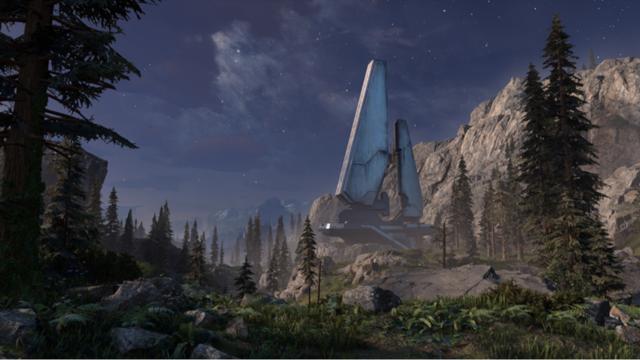
This doesn't mean I don't want more activity within the open world either. Red Dead Redemption II spoiled me with its design. One moment I'm handling a few routine tasks, then I'm swept up in saving this half-dead man – and watching the doctor nonchalantly amputate his gangrenous arm. Although there are occasional ambushes and some signs of life, imagine if there were those kinds of mini-stories woven into the wider narrative. Perhaps Chief does something similar to my Red Dead scenario, which unlocks a two-minute cut scene of him assisting in triaging a wounded soldier. You can palpably feel 343 didn't hit a home run on its open world design, but the ebb 'n flow of encounters still compliments Infinite's non-maximalist checklist approach.
The open world template also reins in the series-expected set pieces and environmental variety. If you're not exploring the Pacific Northwest portion of Zeta, you're either in a Banished or Forerunner installation. Initially, there's a good balance in their size and design intent; later on, it starts getting long-in-the-tooth as it's reaching the conclusion. The combat scenarios within these areas are always exciting, but part of me hoped to see some beaches or snow.
Although these campaign critiques aren't great to end on, they're not massive blows to what's otherwise a fun campaign. Even after acknowledging these missteps, I'm drawn back to making a completionist run and scouring missed nooks and crannies. Even those little extras, like the consistent levity from Grunts, add that bit of flavor not seen in other blockbuster shooters. 343's first open world doesn't reach the dynamism of the industry's best, but its modest scope felt carefully incorporated with the main plot.

If you thought the reinvigorated combat's potential seemed limitless in the campaign, competitive multiplayer ups the ante.
Like the campaign, if you're familiar with Halo MP you'll be quickly accustomed here: arena-based battles varying between Deathmatch and objective-based modes. There are no loadouts; timed weapon, equipment, and vehicle spawns are the rules here. Naturally, each map has a different collection of tools at your disposal. There are some weapon & equipment tweaks as well: you're limited to one equipment slot (but can double up when you're using active camo or over shield), tweaked weapon damage outputs compared to campaign, and equipment additions like the Repulsor's forward deflection ability.
What I appreciate the most in otherwise typical modes and routine strategies is the surprising polish of Infinite at launch. The amount of effort put into QA and map design shouldn't be understated. Ten launch maps (seven mid-size, three big) is a bit scant, but when I only have measured complaints about a couple (Deadlock & Behemoth), that's an incredible improvement since 343's early days with Reach DLC maps. Even with Infinite's lower-tier arenas, careful consideration went into sightlines, weapon placements, risk/reward plays, and other variables. I'll happily comply with a drip-feed of new maps if they maintain this level of quality control.
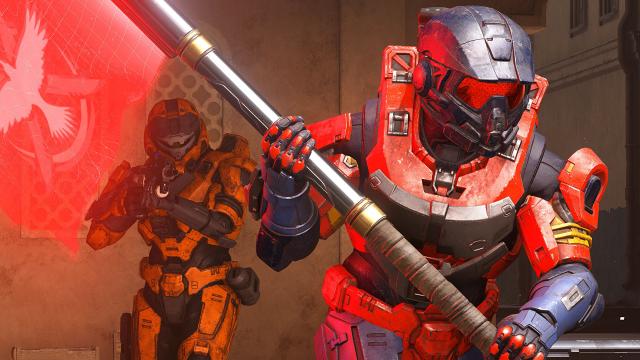
Despite being ameliorated since then, launch modes were also quite limited. If you weren't grouped up with several buddies for Big Team Battle (24 max) then Quick Play and Ranked Arena were your other options. A couple weeks post-release, Fiesta Slayer, Tactical Slayer, Free-For-All, and more were added to the roster. This touches on an annoyance permeating all of Infinite: update culture. With features like Forge and Campaign Co-op promised for later dates, I can't help but be miffed at what could've been here day one.
Recycling previous studio errors, cosmetics and player progression launched and continue to be in an annoying state. Since Infinite's multiplayer is free-to-play (not just "free" to Game Pass members), purchasable in-game currency, an item shop, and seasonal battle passes will be the norm. However you feel about that, my biggest gripe lies more with the battle pass progression itself. Whether it's the drip-feed of xp for finishing a match (regardless of how you performed) or the occasionally dumb weekly that required something that'd otherwise distract from team play, I don't know how it launched in this state. It's been updated to better reward match completions, but the issue with weeklies still stands.
Despite some warts, Infinite is among the best multiplayer 2021 offered. By assessing Halo's past success along with modern expectations, 343 nailed a comfortable middle ground. From paring back 5's standard Spartan suit features to new additions, no stone was left unturned. All of that time testing and recalibrating has resulted in one of my favorite multiplayer titles in recent years.
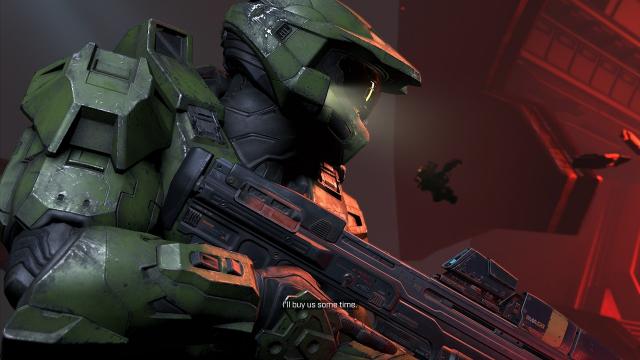
Halo Infinite does often corner me into praising it "in spite of x faults", rather than the "because of y positives" that I'm used to; that said, it's hard to mind when I'm so thoroughly engaged with what's on offer. It's true the delayed content (Forge/Campaign Co-op) and the live-service approach dampen my enthusiasm, but it shows how much still spills over with what's already here. It's the first time in a decade I felt happily subsumed in the Halo universe once again and I don't plan on leaving anytime soon. After a couple of confused sequels and a botched remaster launch, it's nice to see this team act like proper custodians of the series.
Contractor by trade and writer by hobby, Lee's obnoxious criticisms have found a way to be featured across several gaming sites: VGChartz, Gaming Nexus, DarkStation, and TechRaptor! He started gaming in the mid-90s and has had the privilege in playing many games across a plethora of platforms. Reader warning: each click given to his articles only helps to inflate his Texas-sized ego. Proceed with caution.
VGChartz Verdict
8
Great
This review is based on a digital copy of Halo Infinite for the XS
More Articles
I'd probably give it a 9. Which is excellent as I haven't liked any Halo since 3. Halo 1 was a 10, halo 2 was an 8, halo 3 was a 9, halo 4 was a 6, halo 5 was a 7
Good article!
I don’t understand the need to put a spoiler warning in the preffix for Halo 4 and Halo 5, games that came out in 2012 and 2015 respectively. I think the designated spoiler window has passed for them.
Firstly, great review overall!
Secondly, I'm highly invested in The Banished as an antagonist faction because I'm a big fan of the Halo Wars series. But people who haven't played Halo Wars 2 (or at least watched a video of its cut-scenes) may be scratching their heads.
IMO, Halo Infinite should have come with a movie bringing together the Halo Wars 2 cut-scenes, perhaps with a bit of additional exposition, to bring people up to speed. That kind of thing is far without precedent, Shenmue 2 on Xbox came with a DVD of the first Shenmue game cut into a movie format! The Banished have a super cool backstory that is completely lost on anyone who didn't experience Halo Wars 2.
Actually, it occurs to me adding a link to one of the many YouTube videos that cobble together the Halo Wars 2 cut-scenes, as a brush-up for the uninitiated on who the heck The Banished are and what their deal is, and embedding that in the article, would be an improvement to the review. Doing it in your review because Microsoft didn't do it in the game. The Halo Wars cut-scenes (both games) are of famously high quality, and a suggestion to watch that video first would be appreciated by some readers. This one perhaps: https://www.youtube.com/watch?v=-_kBz50zKJ8&t=992s










